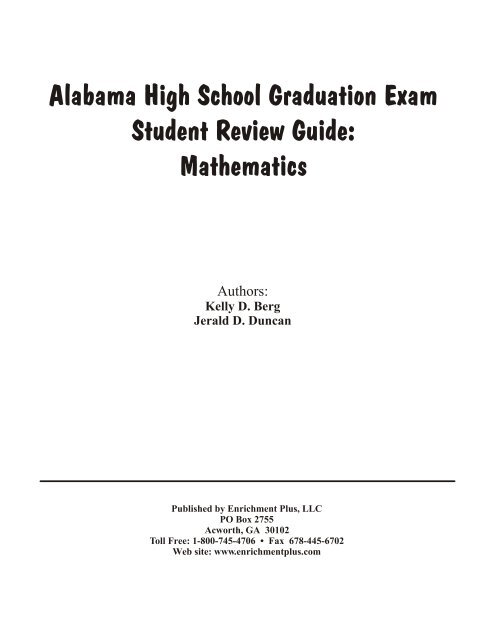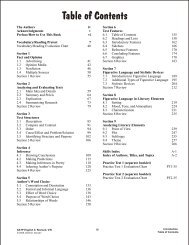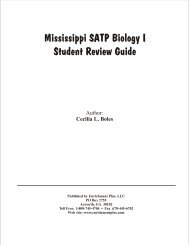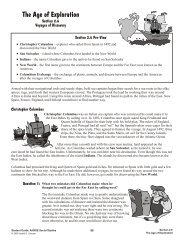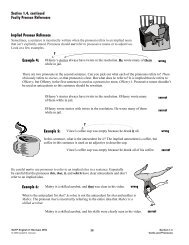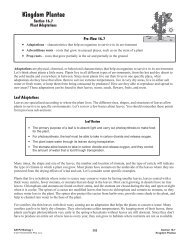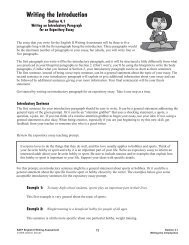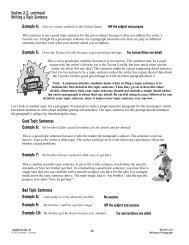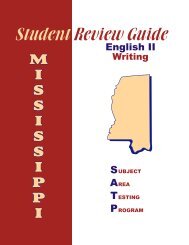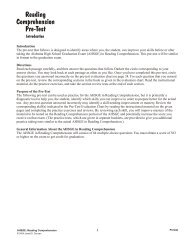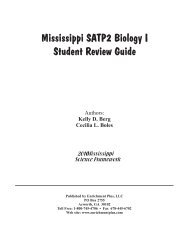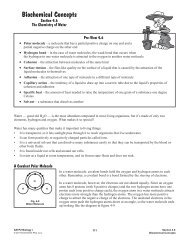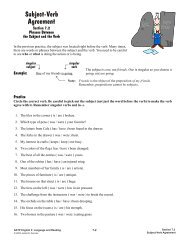Alabama High School Graduation Exam Student ... - Enrichment Plus
Alabama High School Graduation Exam Student ... - Enrichment Plus
Alabama High School Graduation Exam Student ... - Enrichment Plus
Create successful ePaper yourself
Turn your PDF publications into a flip-book with our unique Google optimized e-Paper software.
<strong>Alabama</strong> <strong>High</strong> <strong>School</strong> <strong>Graduation</strong> <strong>Exam</strong><br />
<strong>Student</strong> Review Guide:<br />
Mathematics<br />
Authors:<br />
Kelly D. Berg<br />
Jerald D. Duncan<br />
Published by <strong>Enrichment</strong> <strong>Plus</strong>, LLC<br />
PO Box 2755<br />
Acworth, GA 30102<br />
Toll Free: 1-800-745-4706 • Fax 678-445-6702<br />
Web site: www.enrichmentplus.com
Table of Contents<br />
Author and Acknowledgments v Section 6: Algebra Inequalities<br />
Preface/How To Use This Book vi 6.1 One-Step and Two-Step Inequalities 125<br />
6.2 Inequalities with Fractions 128<br />
Pre-Test 7 6.3 Multi-Step Inequalities 129<br />
Pre-Test Evaluation Chart 36 6.4 Recognizing the Graphs of Inequalities 131<br />
6.5 Solving and Graphing Inequalities 132<br />
Section 1: The Basics of Mathematics 6.6 Compound Inequalities: Conjunctions 134<br />
1.1 Basic Numbers and Operations 37 6.7 Compound Inequalities: Disjunctions 137<br />
1.2 Decimals 38 Section 6 Review 1 140<br />
1.3 Adding Positive and Negative Numbers 41<br />
1.4 Subtracting Positive and Negative Numbers 45 Section 7: Algebra Word Problems<br />
1.5 Multiplying and Dividing Positive and 7.1 Key Words in Word Problems 143<br />
Negative Numbers 48 7.2 Setting Up and Solving Simple Algebra<br />
Section 1 Review 50 Word Problems 146<br />
7.3 Consecutive Integer Problems 149<br />
Section 2: Simple Order of Operations 7.4 Understanding Rates 151<br />
2.1 Introduction to Order of Operations 51 7.5 Introduction to Formulas 155<br />
2.2 Order of Operations with Positive and 7.6 Simple Interest Problems 157<br />
Negative Numbers 54 7.7 Distance, Rate, Time Problems 160<br />
2.3 Exponents 55 Section 7 Review 164<br />
2.4 Grouping Symbols: Parentheses 57<br />
2.5 Grouping Symbols: Absolute Values 59 Section 8: Two Dimensional Geometric Formulas<br />
2.6 Grouping Symbols: Fraction Bars 61 8.1 Perimeter of Polygons 167<br />
Section 2 Review 63 8.2 Area of Polygons 171<br />
8.3 Area Word Problems 174<br />
Section 3: Algebra Basics 8.4 Circumference and Area of Circles 177<br />
3.1 Reviewing Algebra Vocabulary 65 8.5 Square Root Applications in Geometry<br />
3.2 Basics Properties of Mathematics 66 Word Problems 181<br />
3.3 Combining Like Terms 68 Section 8 Review 184<br />
3.4 Multiplying Algebraic Terms by a Constant 70<br />
3.5 Removing Parentheses 72 Section 9: Three Dimensional Geometric Formulas<br />
3.6 Basic Factoring 74 9.1 Volume 187<br />
3.7 Simplifying Rational Expressions 77 9.2 “Real World” Volume Problems 189<br />
3.8 Order of Operations for Algebraic 9.3 Surface Area 193<br />
Expressions 80 Section 9 Review 195<br />
Section 3 Review 82<br />
Section 10: Monomials<br />
Section 4: Algebraic Equations 10.1 Multiplying Variables 197<br />
4.1 The Substitution Principle 83 10.2 Multiplying with Exponents 198<br />
4.2 The Addition Principle 85 10.3 Multiplying Monomials 200<br />
4.3 Multiplying Fractions and Converting 10.4 Powers Raised to Powers 202<br />
Improper Fractions to Mixed Numbers 87 10.5 Simplifying Monomials 204<br />
4.4 The Multiplication Principle 89 10.6 Adding and Subtracting Monomials 205<br />
4.5 Introduction to Multi-Step Equations 94 Section 10 Review 206<br />
4.6 Variables on Both Sides 96<br />
4.7 Equations with Parentheses 99 Section 11: Adding and Subtracting Polynomials<br />
Section 4 Review 101 11.1 Simplifying Polynomials with Addition 209<br />
11.2 Subtracting Polynomials 212<br />
Section 5: Ratios and Proportions 11.3 Fraction Review: Finding the Least Common<br />
5.1 Ratios 103 Multiple 214<br />
5.2 Introduction to Proportions and 11.4 Adding and Subtracting with Unlike<br />
Direct Variation 105 Denominators 216<br />
5.3 Algebraic Proportions 107 11.5 Polynomials with Fractional Coefficients 219<br />
5.4 Interpreting Proportion Word Problems 110 11.6 Adding and Subtracting Rational<br />
5.5 Setting Up and Solving Proportions from Expressions 221<br />
Word Problems 113 11.7 Perimeter Applications 224<br />
5.6 Using Proportions to Convert Units 116 Section 11 Review 227<br />
5.7 Proportion Word Problems with Fractions 119<br />
Section 5 Review 122<br />
AHSGE: Mathematics<br />
© 2006 Jerald D. Duncan<br />
iii<br />
Introduction<br />
Table of Contents
Section 12: Multiplying Polynomials<br />
Section 18: Relations and Functions<br />
12.1 Multiplying a Polynomial by a Monomial 229 18.1 Introducing Relations and Functions 327<br />
12.2 Multiplying Binomials Using FOIL 230 18.2 Function Notation 329<br />
12.3 Special Binomial Products 232 18.3 Types of Functions 332<br />
12.4 Multiplying Rational Expressions 235 18.4 Identifying Functions from Tables 335<br />
12.5 Geometric Area Applications 237 18.5 Determining Domain and Range from<br />
Section 12 Review 239 a Graph 337<br />
18.6 Mapping Relations and Functions 339<br />
Section 13: Factoring Section 18 Review 342<br />
13.1 Greatest Common Factors 241<br />
13.2 Factoring a Common Monomial 243 Section 19: Systems of Equations<br />
13.3 Factoring a Common Binomial 245 19.1 Introducing Systems of Equations 345<br />
13.4 Factoring the Difference of Squares 247 19.2 Solving Systems by Graphing 347<br />
13.5 Factoring a Perfect Square Trinomial 250 19.3 Solving Systems by Substitution 349<br />
13.6<br />
2<br />
Factoring Trinomials x + bx + c 252 19.4 Solving Systems by Elimination 352<br />
13.7<br />
2<br />
Factoring Trinomials ax + bx + c 256 19.5 Mixed Review 355<br />
13.8 Mixed Review 260 19.6 Using Systems to Solve Word Problems 356<br />
Section 13 Review 261 Section 19 Review 360<br />
Section 14: Quadratic Equations<br />
14.1 Introducing Quadratic Equations 263<br />
14.2 Quadratic Equations with Difference<br />
of Squares 265<br />
14.3 Quadratic Equations with a Common<br />
Monomial Factor 267<br />
14.4 Quadratic Equations with a Common<br />
Binomial Factor 269<br />
14.5 Quadratic Equations not in Standard Form 271<br />
14.6 Solving Word Problems with<br />
Quadratic Equations 273<br />
Section 14 Review 277<br />
Section 15: The Coordinate Plane<br />
15.1 Introducing the Coordinate Plane 279<br />
15.2 Plotting Points 280<br />
15.3 Slope 282<br />
15.4 Simplifying Square Roots 286<br />
15.5 Distance Formula 289<br />
15.6 Midpoint Formula 293<br />
Section 15 Review 295<br />
Section 16: Graphing Linear Equations<br />
16.1 Intercepts of a Line 297<br />
16.2 Graphing a Line from Data Points 299<br />
16.3 Horizontal and Vertical Lines 301<br />
16.4 Classifying Slopes 303<br />
16.5 Graphing a Line with a Point and Slope 305<br />
16.6 Slope-Intercept Form of a Line 308<br />
16.7 Graphing a Line Using Slope and<br />
Y-Intercept 310<br />
Section 16 Review 314<br />
Section 17: Writing Linear Equations<br />
17.1 Introducing Linear Equations 317<br />
17.2 Equation of a Line with Point and Slope 318<br />
17.3 Equation of a Line with Two Points 320<br />
17.4 Finding an Equation from a Table 322<br />
Section 17 Review 325<br />
Section 20: Angles and Triangles<br />
20.1 Introducing Angles 363<br />
20.2 Classifying Angles 364<br />
20.3 Complementary and Supplementary<br />
Angles 366<br />
20.4 Problem-Solving with Complementary and<br />
Supplementary Angles 368<br />
20.5 Vertical Angles 370<br />
20.6 Parallel Lines Intersected by a Transversal 373<br />
20.7 Problem-Solving with Parallel Lines and<br />
Transversals 376<br />
20.8 Interior Angles of Polygons 378<br />
20.9 Triangles 379<br />
20.10 Problem-Solving with Triangles 382<br />
Section 20 Review 384<br />
Section 21: Similar Polygons<br />
21.1 Introducing Similarity 387<br />
21.2 Determining Similarity 389<br />
21.3 Setting up Proportions 394<br />
21.4 Using Proportions to Find an Unknown<br />
Dimension 396<br />
21.5 Using Ratio to Compare Other Properties 399<br />
21.6 Problem-Solving with Multiple Polygons 400<br />
Section 21 Review 402<br />
Section 22: The Pythagorean Theorem<br />
22.1 Introducing Right Triangles 405<br />
22.2 Square Root Review 406<br />
22.3 Using the Formula 407<br />
22.4 Applying the Formula 410<br />
Section 22 Review 413<br />
Section 23: Statistics<br />
23.1 Introducing Central Tendency 415<br />
23.2 Calculating the Mean 417<br />
23.3 Problem-Solving with Mean 418<br />
23.4 Calculating the Median 421<br />
23.5 Calculating the Mode 423<br />
23.6 Calculating Range 424<br />
Section 23 Review 425<br />
AHSGE: Mathematics<br />
© 2006 Jerald D. Duncan<br />
iv<br />
Introduction<br />
Table of Contents
Section 24: Probability Practice Test 1 separate booklet<br />
24.1 Introducing Probability 429 (with evaluation chart)<br />
24.2 Simple Events 432<br />
24.3 Compound Independent Events 435 Practice Test 2 separate booklet<br />
24.4 Compound Dependent Events 437 (with evaluation chart)<br />
24.5 Mutually Exclusive Events 439<br />
Section 24 Review 441<br />
Index A-1<br />
The Authors<br />
Kelly Davis Berg graduated from Clemson University in Clemson, South Carolina, where she earned a Bachelor of<br />
Science degree in Chemical Engineering. Besides her background in industrial research, she has worked in the field of<br />
educational publishing for ten years, and she has taught chemistry laboratory skills to students at the high school and<br />
college levels. In addition to her role as project coordinator and executive editor for educational publications in<br />
several subject areas, she has also co-authored books in science and mathematics.<br />
Jerald D. Duncan has been involved with education for the past twenty years and has taught math and science at the<br />
middle school and high school levels. He was also assistant to the Vocational Director, Cobb County <strong>School</strong>s, and the<br />
Apprenticeship Coordinator, Cobb County <strong>School</strong>s. He is a nationally recognized Curriculum Development facilitator<br />
and teacher trainer. He has conducted more than 40 teacher training workshops in over a dozen states in the areas of<br />
Applied Mathematics, Academic and Vocational Integration, Cooperative Learning, and Reading Across the<br />
Curriculum. He is also a CORD certified trainer in the areas of Applied Math, CORD Algebra, CORD Geometry and<br />
Principles of Technology. Jerald is a frequent presenter at the SREB summer conferences and has presented at the<br />
Regional NCTM Conference. He is a graduate of Emmanuel College in Franklin Springs, Georgia, and Georgia State<br />
University in Atlanta, Georgia.<br />
AHSGE: Mathematics v Introduction<br />
© 2006 Jerald D. Duncan<br />
Table of Contents
The <strong>Alabama</strong> <strong>High</strong> <strong>School</strong> <strong>Graduation</strong> <strong>Exam</strong> <strong>Student</strong> Review Guide: Mathematics is written to help students<br />
review the skills needed to pass the Mathematics portion of the <strong>Alabama</strong> <strong>High</strong> <strong>School</strong> <strong>Graduation</strong> <strong>Exam</strong>, Third<br />
Edition (AHSGE). This comprehensive guide is based on the <strong>Alabama</strong> Standards and Objectives developed by the<br />
<strong>Alabama</strong> State Department of Education.<br />
How To Use This Book<br />
<strong>Student</strong>s:<br />
Passing the <strong>Alabama</strong> <strong>High</strong> <strong>School</strong> <strong>Graduation</strong> <strong>Exam</strong> (AHSGE) is required for graduation. The AHSGE is a multiplechoice<br />
exam given in five subject areas: Language, Reading Comprehension, Mathematics, Science, and Social<br />
Studies. This book is a review for the Mathematics portion of the AHSGE.<br />
<br />
<br />
<br />
<br />
<br />
Take the pre-test found in the front of this book. The pre-test covers all the math skills tested on the AHSGE in a<br />
format similar to the actual test. The pre-test is designed to identify areas that you need to review.<br />
Score the pre-test. Using the pre-test evaluation chart, circle the questions that you answered incorrectly.<br />
For each question that you missed on the pre-test, review the corresponding sections in the book. Read the<br />
instructional material, do the practice exercises, and take the section review test at the end of each section.<br />
After reviewing the skills, take the two practice tests (provided as separate booklets). These practice tests are<br />
written to look similar to the actual AHSGE; therefore, they will give you practice in taking the test.<br />
After taking Practice Test 1 and/or Practice Test 2, use the practice test evaluation charts, which are found<br />
directly after each practice test, to identify areas for further review and practice. The practice test evaluation<br />
charts can be used in the same way as the pre-test evaluation chart.<br />
Teachers:<br />
This review guide is also intended to save you, the teacher, time in the classroom. It can be used for classroom<br />
instruction or for individual student review. Since this student guide offers review for ALL of the math skills<br />
necessary for passing the AHSGE in mathematics, it provides you one consolidated resource of material to help your<br />
students prepare for the exam.<br />
<br />
<br />
<br />
<br />
<br />
<br />
Preface<br />
When teaching or tutoring individual students, use the strategy outlined above for students. By taking the pretest,<br />
students can identify areas that need improvement. The pre-test evaluation chart directs the students to the<br />
sections they need to review for instruction and additional practice.<br />
For classroom study, use this guide to supplement lesson plans and to give additional review for skills tested on<br />
the AHSGE. Purchase a class set of guides for use in the classroom or assign guides to students for out-ofclassroom<br />
work.<br />
Assign the practice tests (provided in separate booklets) as comprehensive review tests.<br />
Use the practice test evaluation charts found after each practice test to identify areas needing further review.<br />
You may want to use the pre-test to establish a benchmark for each student. Score the pre-test by counting each<br />
question as 1 point. Then, after the students have completed all the exercises in the workbook, use one or both<br />
practice tests to gauge progress. You should see marked improvement between the initial and final benchmarks.<br />
Please DO NOT photocopy materials from these guides or the practice test booklets. These guides are intended<br />
to be used as student workbooks, and individual pages should not be duplicated by any means without<br />
permission from the copyright holder. To purchase additional or specialized copies of sections in this book,<br />
please contact the publisher at 1-800-745-4706.<br />
AHSGE: Mathematics<br />
© 2006 Jerald D. Duncan<br />
vi<br />
Introduction<br />
Preface
Standard and Objective Correlation Chart<br />
The chart below correlates each standard and objective tested on the AHSGE in Mathematics as given in the <strong>Alabama</strong><br />
State Department of Education to this student guide. The Text Section column gives the section numbers in the text<br />
where each standard and objective is reviewed. The Pretest and Practice Test columns give the question number(s) in<br />
those tests that correlate to each standard and objective.<br />
Standard/Objective: Description<br />
Text Section(s)<br />
Pretest<br />
Practice Test 1<br />
Practice Test 2<br />
I-1:<br />
Apply order of operations<br />
Sections 2 and 3, 11.1, 11.2<br />
1–4<br />
2, 5, 12, 51<br />
1, 8, 15, 21<br />
I-2 Add and subtract polynomials<br />
11.1 – 11.6<br />
5–8<br />
1, 9, 13, 17<br />
18, 24, 41, 90<br />
I-3 Multiply polynomials<br />
Section 10, 12.1 – 12.4<br />
9–13<br />
6, 10, 33, 55<br />
9, 46, 63, 78<br />
I-4 Factor polynomials<br />
Section 13<br />
14–19<br />
18, 21, 52, 69<br />
60, 72, 77, 96<br />
II-1<br />
Solve multi-step equations<br />
Section 4, 5.3<br />
20–22<br />
3, 22, 24, 38<br />
64, 81, 84, 97<br />
II-2<br />
Solve quadratic equations<br />
14.1 – 14.5<br />
23–26<br />
7, 19, 53, 56<br />
5, 22, 61, 95<br />
II-3<br />
Solve systems of linear equations<br />
19.1 – 19.5<br />
27–29<br />
20, 32, 41, 57<br />
65, 85, 87, 91<br />
II-4<br />
Solve multi-step inequalities<br />
6.1, 6.2, 6.3<br />
30–32<br />
4, 44, 45, 54<br />
2, 59, 75, 82<br />
III-1<br />
Identify functions<br />
17.4, 18.1, 18.3, 18.4, 18.6<br />
33–38<br />
31, 40, 58, 100<br />
6, 11, 55, 94<br />
III-2<br />
Find the range of functions<br />
18.1, 18.2, 18.5<br />
39–42<br />
8, 23, 27, 46<br />
3, 27, 62, 80<br />
IV-1<br />
Find perimeter, circumference, area,<br />
volume<br />
8.1 – 8.4, Section 9<br />
43–47<br />
11, 34, 66, 95<br />
25, 48, 73, 89<br />
IV-2<br />
Find the distance, midpoint, slope<br />
Section 15<br />
48–50<br />
25, 47, 72, 97<br />
10, 23, 71, 76<br />
V-1, 4 Graph: Linear Equations; Common<br />
Relations<br />
Section 16, 17.1, 18.3, 18.4<br />
51–54<br />
36, 62, 81,<br />
82, 83, 84<br />
12, 26, 30,<br />
58, 86, 93<br />
V-2 Graph lines given certain conditions<br />
16.1, 16.2, 16.4 – 16.7<br />
55–58<br />
15, 16, 49, 50<br />
29, 56, 57, 98<br />
V-3 Determine solution sets of inequalities<br />
Section 6<br />
59–62<br />
35, 68, 71, 89<br />
28, 45, 51, 54<br />
VI-1<br />
Translate: Verbal or Symbolic<br />
Graph: Equations or Inequalities<br />
6.4, 6.6, 6.7,<br />
7.1, 7.4, 16.7, 17.2, 17.3<br />
63–66<br />
28, 39, 48,<br />
76, 79, 85<br />
13, 16, 36,<br />
43, 67, 88<br />
VII-1<br />
Apply properties and relationships<br />
between angles<br />
Section 20<br />
67–73<br />
14, 37, 73, 87<br />
14, 37, 53, 100<br />
VII-2<br />
Apply Pythagorean Theorem<br />
Section 22<br />
74–75<br />
29, 43, 74, 90<br />
32, 42, 49, 99<br />
VII-3<br />
Apply properties of similar polygons<br />
Section 21<br />
76–78<br />
60, 88, 94, 96<br />
35, 40, 50, 79<br />
VII-4<br />
Apply properties of geometric figures<br />
8.3 – 8.5, 9.2,<br />
11.7, 12.5, 14.6<br />
79–84<br />
42, 59, 61, 63<br />
33, 39, 52, 66<br />
VII-5<br />
Determine measures of central tendency<br />
Section 23<br />
85–88<br />
30, 78, 91, 98<br />
34, 47, 68, 69<br />
VII-6<br />
Determine probabilities<br />
Section 24<br />
89–91<br />
26, 65, 86, 93<br />
17, 20, 38, 70<br />
VII-7<br />
Solve problems: Direct Variation<br />
Section 5<br />
92–95<br />
75, 77, 92, 99<br />
7, 74, 83, 92<br />
VII-8<br />
Solve problems: Algebraic Concepts<br />
Section 7, 14.6, 19.6<br />
96–100<br />
64, 67, 70, 80<br />
4, 19, 31, 44<br />
AHSGE: Mathematics<br />
© 2006 Jerald D. Duncan<br />
492<br />
Appendix<br />
Correlation Chart
Mathematics<br />
Pre-Test<br />
Introduction<br />
Introduction<br />
The pre-test that follows is designed to identify areas where you, the student, can improve your skills before or after<br />
taking the <strong>Alabama</strong> <strong>High</strong> <strong>School</strong> <strong>Graduation</strong> <strong>Exam</strong> (AHSGE) in Mathematics.<br />
Directions<br />
Read each question carefully and darken the circle corresponding to your answer choice. Once you have completed<br />
this pre-test, circle the questions you answered incorrectly on the pre-test evaluation chart on page 36. For each<br />
question that you missed on the pre-test, review the corresponding sections in the book as given in the evaluation<br />
chart. Read the instructional material, do the practice exercises, and take the section review test at the end of each<br />
section.<br />
Purpose of the Pre-Test<br />
The following pre-test can be used as practice for the AHSGE in Mathematics, but it is primarily a diagnostic tool to<br />
help you identify which skills you can improve in order to prepare better for the actual test. Any pre-test question<br />
answered incorrectly may identify a skill needing improvement or mastery. Review the corresponding skill(s)<br />
indicated in the Pre-Test Evaluation Chart by reading the instructional material on the given pages and completing the<br />
practice exercises and reviews. By reviewing each skill, you will improve mastery of the material to be tested on the<br />
Mathematics portion of the AHSGE and potentially increase the score you receive on that exam. (The practice tests,<br />
which are given in separate booklets, are provided to give you additional practice taking tests similar to the actual<br />
AHSGE in Mathematics.)<br />
General Information About the AHSGE in Mathematics<br />
The AHSGE in Mathematics will consist of 100 multiple-choice questions. You must obtain a score of 477 or higher<br />
on the exam to pass.<br />
AHSGE: Mathematics<br />
© 2006 Jerald D. Duncan<br />
7<br />
Pretest
Mathematics Pre-Test<br />
Simplify the following problems. Darken the circle corresponding to your answer choice.<br />
1. Simplify: (3 + 1)<br />
2<br />
÷ 2 – 32<br />
• 2<br />
A –10<br />
B –4<br />
C –2<br />
D 4<br />
5. Simplify: 3x<br />
2<br />
+ xy + 2(x<br />
2<br />
– xy)<br />
A 5x 2<br />
B 5x 4<br />
C 5x<br />
2<br />
– xy<br />
D 5x – xy<br />
4 2 2<br />
A<br />
B C D<br />
A B C D<br />
2. Simplify: 3x – y – (x – y)<br />
6. Simplify: 3.5x – 2 + 0.5x + 1.5<br />
A<br />
B<br />
C<br />
D<br />
4x – 2y<br />
2x – 2y<br />
2x + y<br />
2x<br />
A 2x – 3.5<br />
B 2x + 0.5<br />
C 4x + 3.5<br />
D 4x – 0.5<br />
A B C<br />
D<br />
A B C<br />
D<br />
3. Simplify: |2.1 – 7.4| – 1.5<br />
A –6.8<br />
B 3.8<br />
C 8<br />
D 11<br />
1 1 1 1<br />
7. Simplify: 3 x + 2 y + 2( 6 x + 4 y)<br />
1 1<br />
A<br />
3<br />
x +<br />
2<br />
y<br />
1<br />
B<br />
6<br />
x + y<br />
C x + y<br />
2<br />
D 3 x + y<br />
A B C D<br />
A B C<br />
D<br />
4. Simplify: x +<br />
4x + 6x<br />
2<br />
8. Simplify:<br />
x + 4<br />
2<br />
+<br />
3x – 6<br />
6<br />
A 6x<br />
B 9x<br />
C 11x<br />
D 12x<br />
A x + 1<br />
B 4x – 2<br />
C 6x + 2<br />
D 6x + 12<br />
A<br />
B C D<br />
A<br />
B C D<br />
AHSGE: Mathematics<br />
© 2006 Jerald D. Duncan<br />
9<br />
Pretest
Simple Order<br />
of Operations<br />
Section 2.1<br />
Introduction to Order of Operations<br />
If addition, subtraction, multiplication, and division are the simple math<br />
operations, what happens when you are given a math problem that includes more<br />
than one of these operations? You have to determine which to do first. The rules<br />
that determine what sequence to follow are called order of operations.<br />
<strong>Exam</strong>ple 1:<br />
2 + 4 • 5 = ?<br />
Can you see that there are two different ways of solving this problem? You can add first and then multiply, or<br />
you can multiple first and then add. Which way is the correct way? You get two different answers depending on<br />
how you solve this problem.<br />
Add First, Then Multiply<br />
?<br />
6 • 5 = 30<br />
<br />
If you add first, 2 + 4 is 6. Then once<br />
you multiply, you get 6 • 5, which is 30.<br />
Multiply First, Then Add<br />
?<br />
2 + 20 = 22<br />
<br />
If you multiply first, 4 • 5 is 20. Then once<br />
you add, you get 20 + 2, which is 22.<br />
Which is right? This example shows why order of operations is so important. It tells you the correct sequence<br />
for solving math problems with mixed operations. The correct answer is 22. That means multiplication is to be<br />
done before addition.<br />
The rules for simple arithmetic operations is to work the following order :<br />
1. Multiplication or Division<br />
2. Addition or Subtraction<br />
As you can see, multiplication and division are on the same level, and addition and subtraction are on the same level.<br />
As long as you are deciding between operations on different levels, the order is clear. But what if you have multiple<br />
operations on the same level? Then a rule called the Left Hand Rule becomes very important. It says that when you<br />
have multiple operations on the same level, you simplify them from left to right. Consider the following example.<br />
<strong>Exam</strong>ple 2: 10 – 3 + 60 ÷ 6 • 5<br />
In this problem, there is a division and a multiplication operation, and there is a subtraction and an addition<br />
operation. Remember, multiplication and division must be done first. To solve this problem, find the left most<br />
multiplication or division operation and solve. Repeat until there are no more multiplication or division<br />
operations. Then do the same thing for the addition and subtraction operations. The correct order for solving this<br />
problem is given below.<br />
10 – 3 + 60 ÷ 6 • 5<br />
10 – 3 + 10 • 5<br />
According to the order of operations, 60 ÷ 6 and 6 • 5 are the two<br />
operations that must be performed first. According to the left hand<br />
rule, 60 ÷ 6 should be done first because it is farther left than 6 • 5.<br />
Now perform the next left-most multiplication or division<br />
operation. There is only one left, 10 • 5.<br />
AHSGE: Mathematics<br />
© 2006 Jerald D. Duncan<br />
51<br />
Section 2.1<br />
Simple Order of Operations
Section 2.1, continued<br />
Introduction to Order of Operations<br />
10 – 3 + 50<br />
7 + 50 = 57<br />
Once all the multiplication and division operations are done, you<br />
can perform the addition or subtraction operations starting at the<br />
left. Repeat until the problem is completely solved.<br />
Practice 1<br />
Solve the following math problems by using the correct order of operations. Show all of your work and write<br />
your final answers in the blanks.<br />
1. 7 – 2 • 3 2. 12 ÷ 3 + 6 3. 7 • 4 – 9 + 4<br />
4. 6 + 5 • 4 ÷ 2<br />
5. 6 • 2 ÷ 4 + 9 6. 8 • 3 – 21 ÷ 3 7. 36 ÷ 9 • 3 + 8<br />
8. 1 + 24 ÷ 6 – 2<br />
9. 10 – 2 • 4 + 7 10. 15 ÷ 3 + 5 • 2 11. 3 • 4 ÷ 2 – 3 + 4 12. 12 + 4 – 5 • 4 ÷ 2<br />
AHSGE: Mathematics<br />
© 2006 Jerald D. Duncan<br />
52<br />
Section 2.1<br />
Simple Order of Operations
Algebra Basics<br />
Section 3.8<br />
Order of Operations<br />
for Algebraic Expressions<br />
You’ve already practiced using the correct order of operations for signed numbers. Now, let’s look<br />
at how to use the correct order of operations for simplifying algebraic expressions. Simplifying<br />
these types of problems is not brain surgery. You just have to be careful. Do you remember this<br />
silly sentence?<br />
Greatly Excuse My Dear Aunt Sally<br />
1. Grouping<br />
Symbols<br />
2. Exponents 3. Multiplication<br />
& Division<br />
4. Addition<br />
& Subtraction<br />
<strong>Exam</strong>ple 1: Simplify 2x + y – 5(x + 4y)<br />
You have already reviewed all of the skills you need to solve this problem. Now all you have to remember is the<br />
order. Study the steps below.<br />
2x + y – 5 (x + 4y)<br />
Grouping symbols must be simplified first. In this<br />
problem, the parentheses are a grouping symbol. The<br />
terms in the parentheses cannot be combined because<br />
they are not like terms, BUT you can use the distributive<br />
property to multiply both terms by the constant outside<br />
of the parentheses.<br />
Be careful with the 5 outside the parentheses. The negative sign goes with the number and must be<br />
distributed to both terms inside the parentheses.<br />
2x + y + (– 5) • x + (– 5) • 4y<br />
Multiplication is the next operation to perform.<br />
2x + y – 5x – 20y<br />
Use the associative and commutative properties to<br />
rearrange the terms and to group like terms together.<br />
(2x – 5x) + (y – 20y)<br />
The last step is to combine like terms using addition and<br />
subtraction.<br />
–3x – 19y<br />
This expression is now simplified!<br />
AHSGE: Mathematics<br />
© 2006 Jerald D. Duncan<br />
80<br />
Section 3.8<br />
Algebra Basics
Section 3.8, continued<br />
Order of Operations<br />
for Algebraic Expressions<br />
<strong>Exam</strong>ple 2: Simplify 6x –<br />
5x + x<br />
2 + 1<br />
Now the grouping symbol is the fraction bar. Look at the steps below.<br />
6x – 5x + x<br />
2 + 1<br />
Since the fraction bar is a grouping symbol, the operations above the bar and<br />
below the bar must be performed first. Combine the like terms.<br />
6x –<br />
6x<br />
3<br />
<br />
<br />
6x – 3 • 2 • x<br />
3<br />
6x – 2x<br />
Now factor the numerator. Three is a common factor that will cancel out.<br />
These are like terms that can be combined by subtraction (also known as<br />
“collecting terms”).<br />
4x<br />
The expression simplifies to 4x.<br />
Practice<br />
Simplify the following algebraic expressions by using the correct order of operations. Show your work. Record<br />
your answers in the blanks.<br />
1. 5(3x + 4) + x 2. –3(x – y) – 2x + y 3. 3x – 8 – (x – 3)<br />
2x – 4<br />
3x – 9x<br />
4. 6x + 5. – 2x<br />
6. 2x –<br />
2<br />
3<br />
6x – 9<br />
3<br />
AHSGE: Mathematics<br />
© 2006 Jerald D. Duncan<br />
81<br />
Section 3.8<br />
Algebra Basics
Similar Polygons<br />
Section 21.1<br />
Introducing Similarity<br />
This is part of a conversation overheard on the way to geometry class.<br />
First girl: “Your book bag is just like mine!”<br />
Second girl: “No, it’s not!”<br />
First girl: “It is, too. It has the same shape and everything.”<br />
Second girl: “But it’s a different color.”<br />
First girl: “That doesn’t matter; they still look alike.”<br />
Second girl: “Alike yes, but not exactly the same. Besides, mine is bigger.”<br />
First girl: “OK, OK maybe they’re not exactly alike — but they are similar.”<br />
When it comes to geometry, the idea of objects being exactly alike or just similar is called congruence and<br />
similarity. For objects to be congruent, they must be exactly alike in both size and shape. In similarity, the shape is<br />
the same, but the size is different. The first girl was right about one thing: color doesn’t matter. Let’s look at<br />
something a little easier to compare than book bags.<br />
A 20 mm B E 20 mm F<br />
D<br />
C H<br />
G<br />
Square ABCD is congruent to square EFGH.<br />
Consider the shape of a square. In a square, all the sides<br />
have the same length, and all the angles have the same<br />
measure. If you have two squares with the same side lengths,<br />
then everything else is equal as well. You could actually pick<br />
up the first square and place it on the second square, and<br />
everything would exactly match. If both objects are exactly<br />
the same, they’re congruent. Square ABCD is congruent to<br />
square EFGH. The symbol ( ) means congruent.<br />
Now consider the same two squares, but change the side<br />
length of one to 30 mm. They still look alike, but they aren’t<br />
exactly the same. The angles are still the same, but the size<br />
has changed. Rather than being equal, the side lengths are now<br />
proportional. The squares are now similar — alike, but not<br />
exactly the same. The symbol for similar is ( ). (If you don’t<br />
remember what proportional means, that’s okay. We’ll explain<br />
it again later.)<br />
A<br />
D<br />
20 mm B W 30 mm<br />
C<br />
Z<br />
X<br />
Y<br />
Square ABCD is similar to square WXYZ.<br />
Corresponding Parts<br />
When two geometric figures are similar, parts on one figure will correspond to parts on the other figure.<br />
Corresponding parts can include vertices, sides, and angles. The corresponding sides are not the same length, but they<br />
are in the same position on the figure (relative to the rest of the figure).<br />
Polygons (any closed geometric figure with three or more sides) can be named by listing their vertices. When naming<br />
a polygon, start at any vertex and list the vertices either clockwise or counter-clockwise. To name a second, similar<br />
polygon, the order of the vertices must be the same because the order indicates which point on the first figure<br />
corresponds to the similar point on the second figure.<br />
AHSGE: Mathematics<br />
© 2006 Jerald D. Duncan<br />
387<br />
Section 21.1<br />
Similar Polygons
Section 21.1, continued<br />
Introducing Similarity<br />
An irregularly shaped polygon may help you to better<br />
understand corresponding parts. Look at the two trapezoids<br />
on the right. Trapezoid JKLM is similar to trapezoid QRST.<br />
On the diagram, you can see that side JK corresponds to<br />
side QR. Can you list the other corresponding sides? They<br />
are KL with RS, LM with ST, and MJ with TQ.<br />
M<br />
J<br />
Corresponding Parts<br />
K<br />
Q<br />
L<br />
T<br />
R<br />
S<br />
JKLM<br />
QRST<br />
Just by looking at the names, you can also determine which parts correspond to which.<br />
The positions of the corresponding points line up in the names. Point J corresponds to<br />
point Q, point K to point R, point L to point S, and point M to point T .<br />
What happens if two similar figures are not oriented the same way? Then looking at the names may help you to<br />
identify which parts are similar.<br />
M<br />
J<br />
K<br />
L<br />
S<br />
R<br />
Q<br />
T<br />
In the diagram to the right, trapezoid JKLM is still<br />
similar to trapezoid QRST, but it’s more difficult to<br />
“see” the corresponding parts on the diagrams. Vertex J<br />
still corresponds to vertex Q, but since the figures are<br />
oriented differently, one is on the top of the figure and<br />
the other is on the bottom. Side JK still corresponds to<br />
side QR. Angle Mstill corresponds to angle T.<br />
Which side corresponds to KL? Look<br />
at the names. KL corresponds to RS.<br />
Practice<br />
Each pair of figures below is similar. For each side or angle given on figure 1, identify the corresponding side or<br />
angle on figure 2. The first one is done for you as an example.<br />
triangle JKL triangle MNP<br />
trapezoid ABCD trapezoid WXYZ<br />
________ MN 1. Side JK<br />
________ 2. Side KL<br />
________ 3. Side JL<br />
L<br />
J<br />
1<br />
K<br />
P<br />
M<br />
2<br />
N<br />
________ 7. Side BC<br />
________ 8. Side AD<br />
________ 9. Side CD<br />
triangle RST triangle XYZ<br />
X<br />
________10. Angle D<br />
________ 4. Side ST<br />
________ 5. Side TR<br />
________ 6. Angle R<br />
R<br />
S<br />
1 2<br />
T<br />
Z<br />
Y<br />
A<br />
D<br />
C<br />
1<br />
X<br />
B<br />
Y<br />
2<br />
Z<br />
W<br />
AHSGE: Mathematics 388<br />
Section 21.1<br />
© 2006 Jerald D. Duncan<br />
Similar Polygons
Mathematics Practice Test 1<br />
25. A line segment begins at point (–1, –2) and ends<br />
at point (5, 6). What is the slope of the line<br />
segment?<br />
Slope formula: m =<br />
y– y<br />
2 1<br />
x– x 2 1<br />
28. A pizza delivery company runs a special. They<br />
charge $7.00 per large pizza plus a $2.00<br />
delivery charge. Which equation could be used<br />
to find the total cost for x pizzas?<br />
A<br />
y = 7x + 2<br />
A 1<br />
B –1<br />
B<br />
C<br />
y = (7 + 2)x<br />
y = 2x + 7<br />
C<br />
4<br />
3<br />
D<br />
x<br />
y = 7 + 2<br />
D<br />
3<br />
4<br />
A B C D<br />
A B C D<br />
26. A jar of candy contains 12 orange-flavored<br />
pieces, 10 cherry-flavored pieces, 5 lemonflavored<br />
pieces, and 8 sour-apple flavored<br />
pieces. If a piece of candy is chosen randomly,<br />
what is the probability that it will be either<br />
lemon-flavored or cherry-flavored?<br />
29. Which set of numbers could be the lengths of<br />
the sides of a right triangle?<br />
A<br />
B<br />
C<br />
D<br />
1<br />
7<br />
3<br />
7<br />
2<br />
35<br />
2<br />
49<br />
A {2, 2, 3}<br />
B {4, 5, 6}<br />
C {5, 12, 13}<br />
D {6, 8, 12}<br />
A B C D<br />
A B C D<br />
27. If f(x) = –x<br />
2<br />
+ 3, what is f(–1)?<br />
30. What is the mode of the following data set?<br />
A 1<br />
B 2<br />
C 4<br />
D 5<br />
A 4.2<br />
B 4.5<br />
C 5<br />
D 6<br />
4, 5, 5, 3, 8, 5, 4, 2, 5, 2<br />
A B C D<br />
A B C D<br />
AHSGE: Mathematics PT1-9<br />
Practice Test 1<br />
© 2006 Jerald D. Duncan
Practice Test 1<br />
Evaluation Chart<br />
Note: Section 1 covers basic skills that should be reviewed first before going on to the more specific skills listed for<br />
each question below.<br />
If you missed<br />
question #:<br />
1<br />
2<br />
3<br />
4<br />
5<br />
6<br />
7<br />
8<br />
9<br />
10<br />
11<br />
12<br />
13<br />
14<br />
15<br />
16<br />
17<br />
18<br />
19<br />
20<br />
21<br />
22<br />
23<br />
24<br />
25<br />
26<br />
27<br />
28<br />
29<br />
30<br />
31<br />
32<br />
33<br />
34<br />
Go to<br />
section(s):<br />
3.1, 3.2, 3.3, 11.1<br />
3.1, 3.2, 3.3, 3.5, 3.8, 11.1, 11.2<br />
3.3, 4.1, 4.2, 4.4, 4.5, 4.6<br />
6.1, 6.3<br />
2.1, 2.2, 2.3, 2.4<br />
12.2, 12.3<br />
13.4, 14.2<br />
18.1, 18.2<br />
3.1, 3.2, 3.3, 3.4, 3.5, 3.8, 11.1, 11.2<br />
4.3, 10.1, 10.2, 10.3<br />
8.1, 9.3<br />
3.1, 3.3, 3.6, 3.7, 3.8<br />
3.3, 3.5, 3.8, 11.1, 11.3, 11.4, 11.5<br />
20.1, 20.2, 20.3, 20.5, 20.6, 20.7<br />
15.1, 15.2, 16.1<br />
15.1, 15.2, 16.2<br />
2.1, 2.2, 3.1, 3.2, 3.3, 11.1<br />
13.1, 13.3<br />
13.1, 13.2, 14.3<br />
19.1, 19.3, 19.4, 19.5<br />
13.1<br />
4.1, 4.2, 4.4, 4.5, 4.6, 5.3<br />
18.1, 18.2<br />
4.1, 4.2, 4.4, 4.5, 5.3<br />
15.1, 15.2, 15.3<br />
24.1, 24.2, 24.5<br />
18.1, 18.2<br />
7.1, 7.4<br />
20.1, 20.2, 22.1, 22.2, 22.3<br />
23.1, 23.5<br />
18.1, 18.3<br />
16.6, 16.7, 19.1, 19.2<br />
4.3, 12.2, 12.3, 12.4<br />
8.1<br />
If you missed<br />
question #:<br />
35<br />
36<br />
37<br />
38<br />
39<br />
40<br />
41<br />
42<br />
43<br />
44<br />
45<br />
46<br />
47<br />
48<br />
49<br />
50<br />
51<br />
52<br />
53<br />
54<br />
55<br />
56<br />
57<br />
58<br />
59<br />
60<br />
61<br />
62<br />
63<br />
64<br />
65<br />
66<br />
67<br />
68<br />
Go to<br />
section(s):<br />
6.4, 6.6<br />
16.2, 18.3, 18.4<br />
20.1, 20.2, 20.3, 20.5<br />
4.1, 4.2, 4.3, 4.4<br />
6.4, 6.6, 6.7<br />
17.2, 17.3, 17.4, 18.1, 18.6<br />
19.1, 19.3, 19.4, 19.5<br />
8.5, 9.1, 14.2, 14.5, 14.6<br />
20.1, 20.2, 22.1, 22.2, 22.3, 22.4<br />
6.1, 6.2<br />
6.1, 6.3<br />
18.1, 18.5<br />
15.1, 15.4, 15.5<br />
15.1, 15.3, 17.3<br />
15.1, 15.2, 16.4, 16.5, 16.6, 16.7<br />
15.1, 15.2, 16.4, 16.5<br />
2.1, 2.2, 2.5<br />
13.1, 13.2, 13.6, 13.7<br />
4.2, 13.1, 13.7, 14.1, 14.5<br />
6.1, 6.3<br />
10.1, 10.2, 10.4<br />
13.3, 14.4<br />
19.1, 19.3, 19.4, 19.5<br />
18.1<br />
8.1, 11.7<br />
21.1, 21.2<br />
3.6, 3.7, 8.4, 12.1, 12.5<br />
15.1, 15.2, 16.6, 16.7<br />
9.1<br />
7.1, 7.2, 7.3<br />
24.1, 24.2, 24.4<br />
8.4<br />
7.1, 7.2, 19.3, 19.4, 19.5, 19.6<br />
6.1, 6.3, 6.4, 6.5<br />
If you missed<br />
question #:<br />
69<br />
70<br />
71<br />
72<br />
73<br />
74<br />
75<br />
76<br />
77<br />
78<br />
79<br />
80<br />
81<br />
82<br />
83<br />
84<br />
85<br />
86<br />
87<br />
88<br />
89<br />
90<br />
91<br />
92<br />
93<br />
94<br />
95<br />
96<br />
97<br />
98<br />
99<br />
100<br />
Go to<br />
section(s):<br />
13.1, 13.4<br />
7.1, 7.2, 19.3, 19.4, 19.5, 19.6<br />
6.1, 6.4, 6.5, 6.6<br />
15.1, 15.2, 15.3<br />
20.1, 20.2, 20.3, 20.8, 20.9, 20.10<br />
20.1, 20.2, 22.1, 22.2, 22.3, 22.4<br />
5.1, 5.2, 5.3, 5.4, 5.5<br />
7.1<br />
5.1, 5.2, 5.3, 5.4, 5.5<br />
23.1, 23.6<br />
7.1<br />
7.1, 7.2, 7.4, 7.5, 7.7<br />
18.3, 18.4<br />
15.1, 15.2, 16.6, 16.7<br />
15.1, 15.2, 16.6, 16.7<br />
15.1, 15.2, 16.3, 18.3<br />
16.6, 16.7, 17.3<br />
24.1, 24.2, 24.3<br />
20.1, 20.2, 20.3, 20.5, 20.6, 20.7<br />
21.1, 21.2, 21.3<br />
6.1, 6.3, 6.4, 6.5, 6.7<br />
22.1, 22.2, 22.3<br />
23.1, 23.4<br />
5.1, 5.2, 5.3, 5.4, 5.5, 5.7<br />
24.1, 24.2<br />
21.1, 21.2, 21.3, 21.4<br />
8.2, 8.3<br />
21.1, 21.2, 21.3, 21.4<br />
15.1, 15.6<br />
23.1, 23.2, 23.3<br />
5.1, 5.2, 5.3, 5.4, 5.5, 5.6<br />
18.1, 18.4<br />
AHSGE: Mathematics<br />
© 2006 Jerald D. Duncan<br />
PT1-26<br />
Practice Test 1


